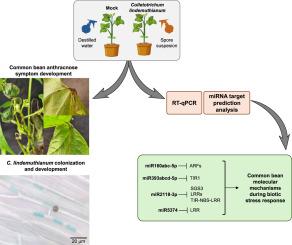MicroRNAs regulate common bean (Phaseolus vulgaris L.) immunity during Colletotrichum lindemuthianum infection
IF 3.3
3区 农林科学
Q2 PLANT SCIENCES
引用次数: 0
Abstract
Anthracnose, caused by the hemibiotrophic fungus Colletotrichum lindemuthianum, poses a major threat to common bean (Phaseolus vulgaris L.) production, leading to substantial yield losses worldwide. Understanding the molecular mechanisms underlying plant defense is essential for developing genetic resistance strategies. Among these mechanisms, microRNAs (miRNAs) play a crucial role in post-transcriptional gene regulation, modulating key pathways involved in plant immunity. This study investigates the expression dynamics of miRNAs in P. vulgaris during C. lindemuthianum infection and predicts their potential regulatory targets. RT-qPCR was employed to assess the temporal expression profiles of selected miRNAs, revealing distinct regulatory patterns throughout pathogen establishment and disease progression. Target prediction supported their potential roles in modulating host defense. The downregulation of miR160abc-5p and miR393abcd-5p suggests their involvement in auxin signaling pathways, essential for balancing growth and immunity responses. Interestingly, miR2118-3p and miR5374 were upregulated at 48 h after infection (hai), while miR2118-3p expression declined at 96 hai in inoculated plants, indicating stage-specific. Both miR2118-3p and the legume-specific miR5374 were predicted to target NBS-LRR and LRR resistance genes, suggesting roles in the fine-tuning or suppression of immune responses. The expression of miR5374, in particular, may facilitate pathogen colonization by repressing key defense components. This study provides valuable data on the expression patterns of specific miRNAs and identifies their potential targets, suggesting their involvement in the P. vulgaris response to C. lindemuthianum. These findings contribute to a more comprehensive understanding of the molecular mechanisms governing plant-pathogen interactions.

MicroRNAs调节普通豆(Phaseolus vulgaris L.)在炭疽杆菌感染期间的免疫
炭疽病是由半生物营养真菌炭疽菌(Colletotrichum lindemuthianum)引起的,对普通豆(Phaseolus vulgaris L.)生产构成重大威胁,在世界范围内导致大量产量损失。了解植物防御的分子机制对于开发遗传抗性策略至关重要。在这些机制中,microRNAs (miRNAs)在转录后基因调控中起着至关重要的作用,调节了参与植物免疫的关键途径。本研究旨在研究普通假单胞菌感染过程中mirna的表达动态,并预测其潜在的调控靶点。RT-qPCR用于评估所选mirna的时间表达谱,揭示了病原体建立和疾病进展过程中不同的调控模式。目标预测支持它们在调节宿主防御中的潜在作用。miR160abc-5p和miR393abcd-5p的下调表明它们参与生长素信号通路,对平衡生长和免疫应答至关重要。有趣的是,miR2118-3p和miR5374在感染后48 h (hai)表达上调,而miR2118-3p在接种植株96 hai时表达下降,这表明了阶段特异性。据预测,miR2118-3p和豆类特异性miR5374都能靶向NBS-LRR和LRR抗性基因,提示其在微调或抑制免疫应答中起作用。特别是miR5374的表达可能通过抑制关键防御成分来促进病原体定植。本研究提供了特异性mirna表达模式的宝贵数据,并确定了它们的潜在靶点,表明它们参与了P. vulgaris对C. lindemuthianum的反应。这些发现有助于更全面地了解植物与病原体相互作用的分子机制。
本文章由计算机程序翻译,如有差异,请以英文原文为准。
求助全文
约1分钟内获得全文
求助全文
来源期刊
CiteScore
4.30
自引率
7.40%
发文量
130
审稿时长
38 days
期刊介绍:
Physiological and Molecular Plant Pathology provides an International forum for original research papers, reviews, and commentaries on all aspects of the molecular biology, biochemistry, physiology, histology and cytology, genetics and evolution of plant-microbe interactions.
Papers on all kinds of infective pathogen, including viruses, prokaryotes, fungi, and nematodes, as well as mutualistic organisms such as Rhizobium and mycorrhyzal fungi, are acceptable as long as they have a bearing on the interaction between pathogen and plant.

 求助内容:
求助内容: 应助结果提醒方式:
应助结果提醒方式:


